-
 Bitcoin
Bitcoin $106,754.6083
1.33% -
 Ethereum
Ethereum $2,625.8249
3.80% -
 Tether USDt
Tether USDt $1.0001
-0.03% -
 XRP
XRP $2.1891
1.67% -
 BNB
BNB $654.5220
0.66% -
 Solana
Solana $156.9428
7.28% -
 USDC
USDC $0.9998
0.00% -
 Dogecoin
Dogecoin $0.1780
1.14% -
 TRON
TRON $0.2706
-0.16% -
 Cardano
Cardano $0.6470
2.77% -
 Hyperliquid
Hyperliquid $44.6467
10.24% -
 Sui
Sui $3.1128
3.86% -
 Bitcoin Cash
Bitcoin Cash $455.7646
3.00% -
 Chainlink
Chainlink $13.6858
4.08% -
 UNUS SED LEO
UNUS SED LEO $9.2682
0.21% -
 Avalanche
Avalanche $19.7433
3.79% -
 Stellar
Stellar $0.2616
1.64% -
 Toncoin
Toncoin $3.0222
2.19% -
 Shiba Inu
Shiba Inu $0.0...01220
1.49% -
 Hedera
Hedera $0.1580
2.75% -
 Litecoin
Litecoin $87.4964
2.29% -
 Polkadot
Polkadot $3.8958
3.05% -
 Ethena USDe
Ethena USDe $1.0000
-0.04% -
 Monero
Monero $317.2263
0.26% -
 Bitget Token
Bitget Token $4.5985
1.68% -
 Dai
Dai $0.9999
0.00% -
 Pepe
Pepe $0.0...01140
2.44% -
 Uniswap
Uniswap $7.6065
5.29% -
 Pi
Pi $0.6042
-2.00% -
 Aave
Aave $289.6343
6.02%
What are the characteristics of the divergence between the WR indicator and the price? How to grasp the reversal signal of the oversold area?
Divergence between the WR indicator and price can signal potential reversals in crypto; traders should confirm with candlestick patterns and volume for accuracy.
Jun 16, 2025 at 11:21 am

The divergence between the Williams %R (WR) indicator and price action is a crucial concept for traders looking to identify potential reversal signals in the cryptocurrency market. Understanding the characteristics of this divergence and knowing how to effectively use the WR indicator in oversold areas can significantly enhance trading strategies. This article will delve into the specifics of these topics, providing detailed insights and operational guidance.
Characteristics of Divergence Between WR Indicator and Price
Divergence occurs when the price of a cryptocurrency and the WR indicator move in opposite directions. This phenomenon is a strong indication that the current trend may be losing momentum, potentially leading to a reversal. There are two main types of divergence: bullish divergence and bearish divergence.
Bullish divergence is observed when the price of a cryptocurrency forms a lower low, but the WR indicator forms a higher low. This suggests that selling pressure is decreasing, and a potential upward reversal could be on the horizon. Conversely, bearish divergence occurs when the price forms a higher high, but the WR indicator forms a lower high. This indicates that buying momentum is waning, and a downward reversal might be imminent.
To effectively identify these divergences, traders need to closely monitor the price movements and the corresponding WR indicator values. A clear divergence is often a precursor to significant price movements, making it a valuable tool for anticipating market shifts.
Understanding the WR Indicator
The Williams %R indicator, developed by Larry Williams, is a momentum indicator that measures overbought and oversold levels. It oscillates between 0 and -100, with readings above -20 typically indicating overbought conditions and readings below -80 indicating oversold conditions.
The formula for the WR indicator is:
[ \text{WR} = \frac{\text{Highest High} - \text{Close}}{\text{Highest High} - \text{Lowest Low}} \times -100 ]
Where:
- Highest High is the highest price over a specified period.
- Lowest Low is the lowest price over the same period.
- Close is the closing price of the current period.
By understanding this formula, traders can better interpret the WR indicator's movements and their implications for the cryptocurrency's price.
Grasping the Reversal Signal in Oversold Areas
When the WR indicator enters the oversold zone (below -80), it signals that the cryptocurrency may be undervalued and due for a potential upward correction. However, not all oversold conditions lead to immediate reversals. To effectively grasp the reversal signal, traders should look for additional confirmation signals.
Steps to identify a reversal signal in an oversold area:
- Monitor the WR indicator: Look for the WR value to dip below -80, indicating an oversold condition.
- Check for divergence: If the price forms a lower low while the WR indicator forms a higher low, this is a bullish divergence and a potential reversal signal.
- Look for price action confirmation: Wait for a bullish candlestick pattern, such as a hammer or a bullish engulfing pattern, to confirm the reversal.
- Volume analysis: An increase in trading volume during the potential reversal can provide additional confirmation.
By combining these steps, traders can increase the likelihood of accurately identifying a reversal signal in an oversold area.
Practical Application of WR Indicator and Divergence
To apply the WR indicator and divergence in real trading scenarios, consider the following example involving a popular cryptocurrency like Bitcoin.
- Step 1: Set up the WR indicator: Add the WR indicator to your trading chart with a default period of 14. Adjust the period based on your trading timeframe.
- Step 2: Identify an oversold condition: Look for the WR value to drop below -80, indicating Bitcoin is potentially oversold.
- Step 3: Look for bullish divergence: Monitor the price and WR indicator for a bullish divergence. For instance, if Bitcoin's price forms a lower low at $25,000 and then another lower low at $24,000, but the WR indicator forms a higher low at -85 and then -82, this is a bullish divergence.
- Step 4: Confirm the reversal: Wait for a bullish candlestick pattern to form at the second low. If a hammer candlestick appears at $24,000, this could confirm the potential reversal.
- Step 5: Enter a trade: Consider entering a long position on Bitcoin once the reversal is confirmed, setting a stop-loss below the recent low to manage risk.
By following these steps, traders can effectively use the WR indicator and divergence to identify potential reversal points in the cryptocurrency market.
Common Mistakes to Avoid
When using the WR indicator and divergence, traders should be aware of common pitfalls that can lead to inaccurate signals and poor trading decisions.
- Ignoring other indicators: Relying solely on the WR indicator and divergence without considering other technical indicators or market conditions can lead to false signals.
- Overtrading: Entering trades based on every minor divergence or oversold condition can result in excessive trading and potential losses.
- Neglecting risk management: Failing to set appropriate stop-losses and position sizes can expose traders to significant risk, especially in volatile cryptocurrency markets.
By understanding these common mistakes and taking steps to avoid them, traders can improve their overall trading performance.
Frequently Asked Questions
Q: Can the WR indicator be used effectively on all timeframes?
A: Yes, the WR indicator can be used on various timeframes, from short-term intraday charts to longer-term weekly or monthly charts. However, the effectiveness of the indicator may vary depending on the timeframe and the specific cryptocurrency being traded. Traders should experiment with different periods and timeframes to find what works best for their trading style.
Q: How does the WR indicator compare to other momentum indicators like the RSI?
A: The WR indicator and the Relative Strength Index (RSI) are both momentum indicators used to identify overbought and oversold conditions. The main difference is in their calculation and interpretation. The WR indicator oscillates between 0 and -100, with readings below -80 indicating oversold conditions, while the RSI ranges from 0 to 100, with readings below 30 indicating oversold conditions. Both can be used to identify divergences, but traders often find that the WR indicator is more sensitive to short-term price movements.
Q: Is it necessary to use the WR indicator in conjunction with other technical analysis tools?
A: Yes, using the WR indicator in conjunction with other technical analysis tools can enhance its effectiveness. Combining the WR indicator with trend lines, moving averages, and other momentum indicators can provide a more comprehensive view of the market and help confirm potential reversal signals. This multi-faceted approach can lead to more accurate trading decisions.
Q: How can traders avoid false signals when using the WR indicator?
A: To avoid false signals, traders should look for confirmation from other indicators and price action. For instance, a bullish divergence on the WR indicator should be accompanied by a bullish candlestick pattern and increased trading volume to validate the potential reversal. Additionally, traders should be patient and wait for clear signals rather than acting on every minor fluctuation in the WR indicator.
Disclaimer:info@kdj.com
The information provided is not trading advice. kdj.com does not assume any responsibility for any investments made based on the information provided in this article. Cryptocurrencies are highly volatile and it is highly recommended that you invest with caution after thorough research!
If you believe that the content used on this website infringes your copyright, please contact us immediately (info@kdj.com) and we will delete it promptly.
- 2025-W Uncirculated American Gold Eagle and Dr. Vera Rubin Quarter Mark New Products
- 2025-06-13 06:25:13
- Ruvi AI (RVU) Leverages Blockchain and Artificial Intelligence to Disrupt Marketing, Entertainment, and Finance
- 2025-06-13 07:05:12
- H100 Group AB Raises 101 Million SEK (Approximately $10.6 Million) to Bolster Bitcoin Reserves
- 2025-06-13 06:25:13
- Galaxy Digital CEO Mike Novogratz Says Bitcoin Will Replace Gold and Go to $1,000,000
- 2025-06-13 06:45:13
- Trust Wallet Token (TWT) Price Drops 5.7% as RWA Integration Plans Ignite Excitement
- 2025-06-13 06:45:13
- Ethereum (ETH) Is in the Second Phase of a Three-Stage Market Cycle
- 2025-06-13 07:25:13
Related knowledge
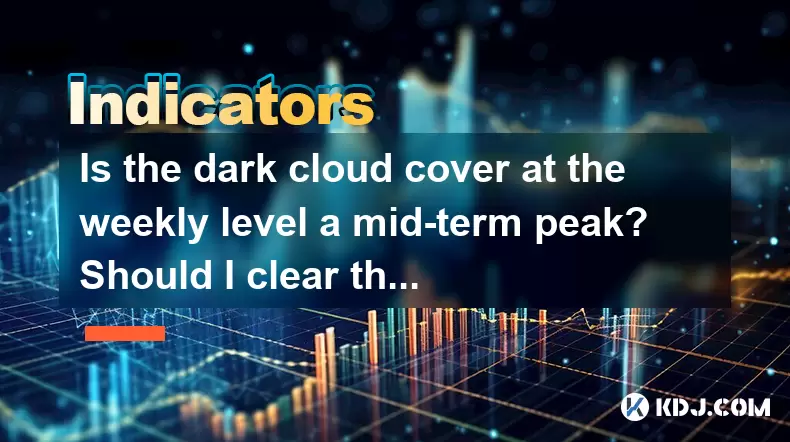
Is the dark cloud cover at the weekly level a mid-term peak? Should I clear the position?
Jun 17,2025 at 02:21pm
Understanding the Dark Cloud Cover PatternThe Dark Cloud Cover is a well-known candlestick pattern used by technical analysts to identify potential trend reversals from bullish to bearish. It typically forms at the end of an uptrend and consists of two candles: the first is a strong bullish (green) candle, followed by a bearish (red) candle that opens h...
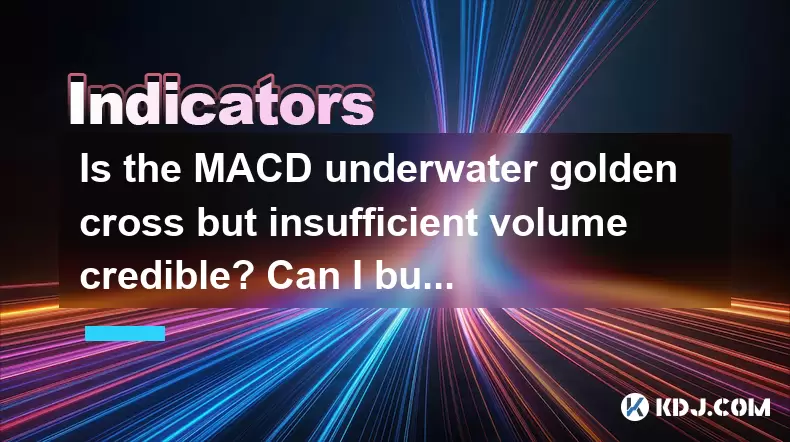
Is the MACD underwater golden cross but insufficient volume credible? Can I buy at the bottom?
Jun 17,2025 at 03:08pm
Understanding the MACD Underwater Golden CrossThe MACD underwater golden cross occurs when the MACD line crosses above the signal line below the zero line, signaling a potential reversal from a downtrend to an uptrend. This phenomenon is often interpreted by traders as a bullish signal, especially in cryptocurrency markets where momentum plays a signifi...
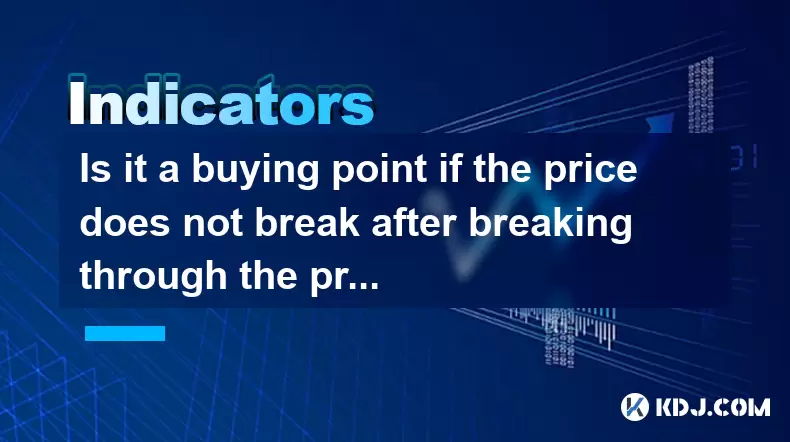
Is it a buying point if the price does not break after breaking through the previous high? How to confirm?
Jun 17,2025 at 01:22pm
Understanding Price Behavior After Breaking Previous HighsWhen analyzing cryptocurrency price charts, traders often look for breakouts as potential signals for new trends. A common question among traders is whether a non-breakdown after breaking through a previous high indicates a buying opportunity. To answer this, it's essential to understand the psyc...
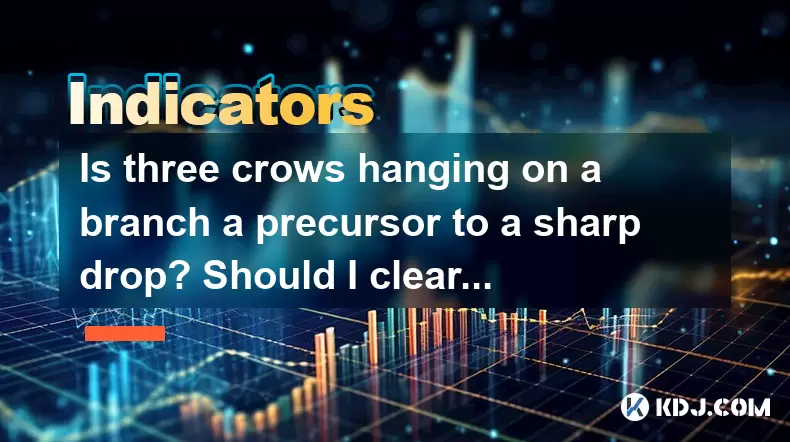
Is three crows hanging on a branch a precursor to a sharp drop? Should I clear my position?
Jun 17,2025 at 12:50pm
What Does 'Three Crows Hanging on a Branch' Mean in Crypto Trading?In technical analysis, the 'three crows hanging on a branch' is a candlestick pattern that often signals a potential reversal from an uptrend to a downtrend. This pattern typically appears after a period of rising prices and consists of three consecutive bearish (red) candles with progre...
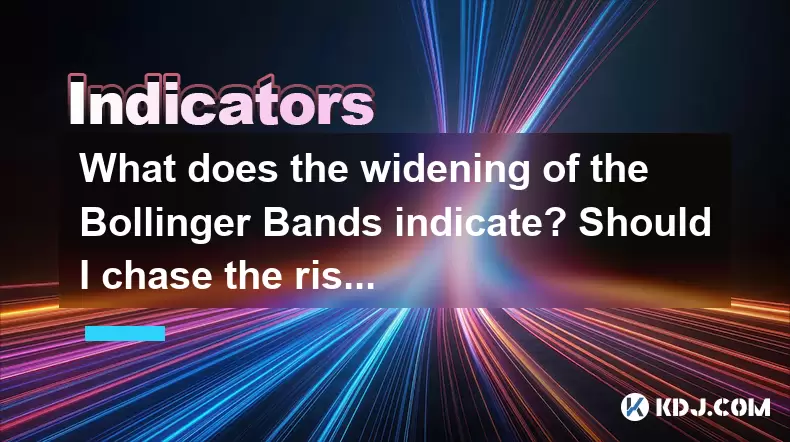
What does the widening of the Bollinger Bands indicate? Should I chase the rise or leave the market?
Jun 17,2025 at 02:28pm
Understanding Bollinger Bands and Their SignificanceBollinger Bands are a widely used technical analysis tool in cryptocurrency trading. They consist of a moving average (typically a 20-day simple moving average) with two standard deviation lines plotted above and below it. These bands dynamically adjust to price volatility, expanding when volatility in...
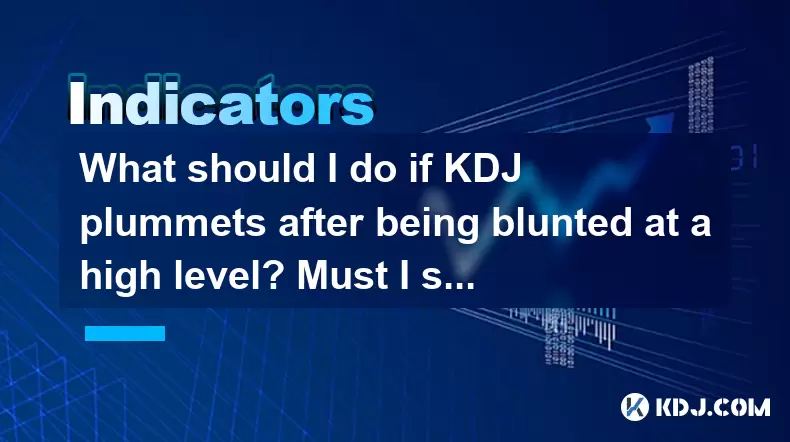
What should I do if KDJ plummets after being blunted at a high level? Must I stop loss?
Jun 17,2025 at 12:01pm
Understanding KDJ Indicator Dynamics in Cryptocurrency TradingThe KDJ indicator, also known as the stochastic oscillator, is a momentum-based tool used to identify overbought and oversold conditions in financial markets, including cryptocurrency. It consists of three lines: the %K line (fast stochastic), the %D line (slow stochastic), and the %J line (d...

Is the dark cloud cover at the weekly level a mid-term peak? Should I clear the position?
Jun 17,2025 at 02:21pm
Understanding the Dark Cloud Cover PatternThe Dark Cloud Cover is a well-known candlestick pattern used by technical analysts to identify potential trend reversals from bullish to bearish. It typically forms at the end of an uptrend and consists of two candles: the first is a strong bullish (green) candle, followed by a bearish (red) candle that opens h...

Is the MACD underwater golden cross but insufficient volume credible? Can I buy at the bottom?
Jun 17,2025 at 03:08pm
Understanding the MACD Underwater Golden CrossThe MACD underwater golden cross occurs when the MACD line crosses above the signal line below the zero line, signaling a potential reversal from a downtrend to an uptrend. This phenomenon is often interpreted by traders as a bullish signal, especially in cryptocurrency markets where momentum plays a signifi...

Is it a buying point if the price does not break after breaking through the previous high? How to confirm?
Jun 17,2025 at 01:22pm
Understanding Price Behavior After Breaking Previous HighsWhen analyzing cryptocurrency price charts, traders often look for breakouts as potential signals for new trends. A common question among traders is whether a non-breakdown after breaking through a previous high indicates a buying opportunity. To answer this, it's essential to understand the psyc...

Is three crows hanging on a branch a precursor to a sharp drop? Should I clear my position?
Jun 17,2025 at 12:50pm
What Does 'Three Crows Hanging on a Branch' Mean in Crypto Trading?In technical analysis, the 'three crows hanging on a branch' is a candlestick pattern that often signals a potential reversal from an uptrend to a downtrend. This pattern typically appears after a period of rising prices and consists of three consecutive bearish (red) candles with progre...

What does the widening of the Bollinger Bands indicate? Should I chase the rise or leave the market?
Jun 17,2025 at 02:28pm
Understanding Bollinger Bands and Their SignificanceBollinger Bands are a widely used technical analysis tool in cryptocurrency trading. They consist of a moving average (typically a 20-day simple moving average) with two standard deviation lines plotted above and below it. These bands dynamically adjust to price volatility, expanding when volatility in...

What should I do if KDJ plummets after being blunted at a high level? Must I stop loss?
Jun 17,2025 at 12:01pm
Understanding KDJ Indicator Dynamics in Cryptocurrency TradingThe KDJ indicator, also known as the stochastic oscillator, is a momentum-based tool used to identify overbought and oversold conditions in financial markets, including cryptocurrency. It consists of three lines: the %K line (fast stochastic), the %D line (slow stochastic), and the %J line (d...
See all articles

























































































